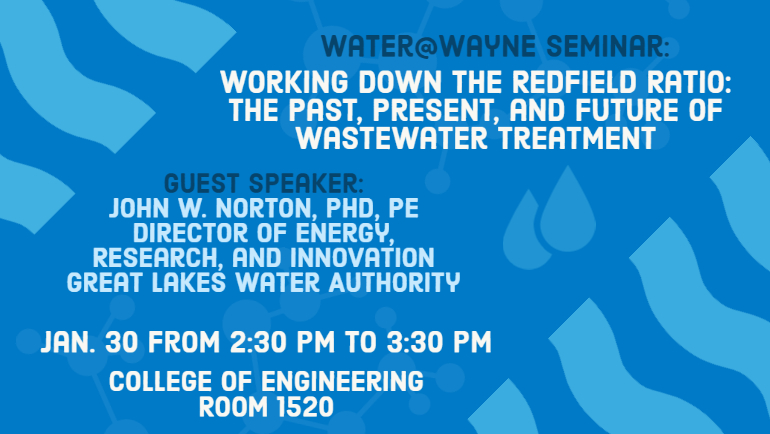Water@Wayne Seminar - "Working Down the Redfield Ration: The Past, Present and Future of Wasterwater Treatment"

The Office of the Vice President of Research is pleased to host the next Water@Wayne seminar on Thursday, January 30, 2020 from 2:30 p.m. to 3:30 p.m. in the College of Engineering, room 1520. The seminar is free and open to the public; registration is requested. To register, visit here.
The Water@Wayne seminar series presents, "Working Down the Redfield Ratio: The Past, Present, and Future of Wastewater Treatment," with guest speaker Dr. John W. Norton, Jr., PhD, PE, Director of Energy, Research, and Innovation, Great Lakes Water Authority.
The Great Lakes Water Authority (GLWA)produces almost 40% of the water and treats almost 30% of the wastewater for the State of Michigan. Dr. Norton coordinates the energy, research, and innovation teams for GLWA. He has been an invited speaker on water and energy systems at Harvard, Northwestern, UCLA, University of Michigan, Columbia, the Incheon, South Korea regional government, along with more than 45 other universities and regional governments around the world. Dr. Norton has a PhD in civil and environmental engineering from the University of Michigan, Ann Arbor.
Abstract:
The Redfield ratio describes the relative fractions of carbon, nitrogen, phosphorus, and other elements in typical microbial systems. The typical ratio is something along the lines of 115:15:1, respectively, for carbon, nitrogen, and phosphorus. One hundred and fifty years ago the wastewater treatment focus was on carbon because of it’s impact on aqueous oxygen concentration. About 75 years ago wastewater treatment began an additional focus on nitrogen due to ammonia toxicity. In the past 15 to 20 years the water sector focus grew to include phosphorus removal due to its role as a trace nutrient in water systems. An evaluation of the typical Redfield ratio elemental concentrations shows the next few elements after phosphorus are zinc, iron, sulfur, and other elements that are not significantly limited within water systems. Essentially, phosphorus is the end of the “growth-limiting” elemental nutrients found within typical wastewater flows. We are now starting to see the increasing treatment focus of specific compounds and classes of chemical constituents driving the regulatory environment, e.g., PFAS, endocrine disruptors, microplastics, and so forth. The rise of these compounds as regulatory drivers will have significant implications on wastewater collection and treatment. The future may see specific treatment technologies used to address specific compounds or co-located “higher cost” treatment processes adjacent to specific contaminant sources. The goal then will be to find the optimal mix of technologies that address and provide as many ancillary treatment benefits as possible to minimize overall costs. This talk will describe these scientific and regulatory drivers, the nature of the emerging new contaminants, and the potential for new treatment regimes to address these issues.
Contact info
Julie O'Connor
Director, Research Communications
Phone: 313-577-8845
Email: julie.oconnor@wayne.edu